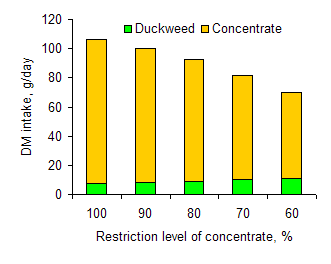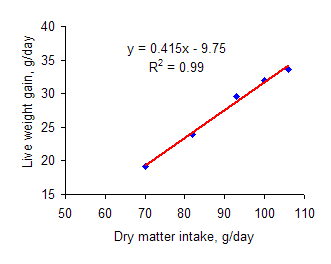Effect of level of fresh duckweed (Lemna
minor)in diets of
chickens raised in confinement
Du Thanh Hang
Hue University of Agriculture and Forestry, Hue
hangtuat@pmail.vnn.vn
hangtuat@pmail.vnn.vn
Abstract
Forty-five Luong Phuong chickens at 30 days of age were randomly distributed into 3 replications of five treatments (3 chickens per experimental unit). The birds were offered a basal diet based on maize and a commercial concentrate mixture (30:70 ratio; 16% crude protein in the DM) offered ad libitum or restricted to 60, 70, 80 or 90% of the ad libitum intake. On all the diets the birds had free access to fresh duck weed.
When the concentrate was freely available, the chickens consumed fresh duckweed in amounts equivalent to 7% of the total DM intake and 15% of the total protein intake, giving a protein content in the diet DM of 17.5%. These proportions increased to 15 and 30%, for DM and protein, respectively, and the overall protein content of the diet increased to 19.4%, when the concentrate offer level was reduced to 60% of ad libitum intake. Feed DM intake, live weight gain and feed DM conversion became poorer as the proportion of duckweed in the diet increased, and there was no saving in concentrate usage per unit live weight gain.
Under the conditions of the present study, with a basal diet of
maize and protein supplement (16% protein in DM) supplemented with fresh duck
weed ad libitum, there was no advantage in restricting the intake of the
concentrate. The chickens were unable to eat enough fresh duck weed to
compensate for the restriction in the concentrate allowance.
Key words: Duckweed, chicken, protein and dry
matter
Introduction
In Central Vietnam, protein-rich feed resources for monogastric animals in general and for chickens in particular are scarce and expensive. The main protein sources are fishmeal and groundnut cake but the prices are relatively high (about 3000 to 6000 VND/kg), and storage is also a problem, particularly in the case of groundnut cake. Preston (1994) has proposed that possible alternatives to these conventional protein meals are the leaves of forage trees and shrubs and water plants
The potential nutritive value of duckweed (Lemna minor) in poultry diets has long been recognized (Lautner and Mueller 1954; Musaffarov 1968; Abdullaev 1969; Haustein et al 1988). Duckweed has also received research attention because of its great potential to remove mineral contaminants from waste-waters emanating from sewage works. When effectively managed in this way duckweed can yield from 10 to 30 tonnes DM/ha/year containing up to 43% crude protein, 5% lipids and a highly digestible dry matter (Leng 1999).
Haustein et al (1988) suggested that although earlier studies had included duckweed in poultry feeds at relatively low concentrations (5 to 10% in DM), this was with duckweed of poor quality (high fiber and ash, and less than 20% protein). With higher quality duckweed (from 30 to 40 % protein, low ash, high carbohydrate), Haustein et al (1988) reported that duckweed could substitute most of the soybean meal and fish meal in diets of laying hens. According to these authors, the optimal level of duckweed in the diet was 15% but even at 40%, egg quality was not affected. However, an important point is that in these experiments the duckweed was dehydrated to a dry meal.
Dehydration of duckweed is rarely feasible at the level of small scale farmers, because of it high moisture content (about 95%). This study therefore aimed to evaluate the feeding of fresh duckweed as a supplement to a maize / concentrate diet.
Material and Methods
Experimental design
Forty-five Luong Phuong chickens at 30 days of age, with average weight 80g, were randomly distributed into 3 replications of five treatments (3 chickens per experimental unit). Over a 30 day experimental period the birds were given a basal diet based on maize and a commercial concentrate mixture offered ad libitum or restricted to 60, 70, 80 or 90% of the ad libitum intake. On all the diets the birds had free access to fresh duck weed. The basal diet was ground yellow maize + concentrate feed (X4000 from VIFOCO company with 42% crude protein), mixed in a 30:70 ratio to give a diet with 16% crude protein in the DM.
Housing system
Three temporary structures (considered as replications) made of bamboo matting and fence posts were built to house the chickens. Each house was separated into 5 pens measuring 0.5 m x 1m using wooden frames and heavy commercial grade wire mesh. Each pen was provided with two feeders (one for concentrate and one for duckweed) and an automatic watering device.
Feeding system
Duckweed was collected from natural ponds, washed with clean water, and offered ad libitum according to the following procedure: approximately 70% of the total duckweed offered (the exact amount was recorded) was mixed with the concentrate and offered in four meals during the day in one of the feed troughs. The remaining 30% of the duckweed was offeredin a separate feed trough.
Measurements
An adaptation period of 10 days
was allowed before starting the collection of data. Feed offered and refused
was then measured daily before and after each of the meals. The weight of each
chicken was recorded every 5 days. Samples of feed were taken every 5 days and
analysed for dry matter and crude protein according to AOAC (1995) procedures. After finishing the 30 day trial, 3 chickens
from each treatment were slaughtered to determine the weights of carcass and
offals (intestine, gizzard and liver) and to record presence of parasites.
Results and Discussion
The intake of duckweed increased as the degree
of restriction of the concentrate was increased (Table 1); but this did not compensate for the reduced
intake of concentrate, thus total DM intake declined (Figure 1), which in turn
led to a reduced live weight gain (Figure 2).
|
Table 1:
Effect of reducing the offer level of concentrate on feed intake and live
weight gain of Luong Phuong chickens (duckweed was offered ad libitum on all
treatments ) |
|||||||
|
|
Offer level of concentrate (% of ad libitum) |
|
|||||
|
|
60 |
70 |
80 |
90 |
100 |
SEM/Prob |
|
|
Feed intake, g/chicken/day |
|
|
|
||||
|
Fresh duckweed |
172 |
163 |
138 |
121 |
115 |
13/0.008 |
|
|
Duckweed DM |
11.1 |
10.6 |
8.9 |
7.9 |
7.5 |
0.84/0.008 |
|
|
Duckweed protein |
4.3 |
4.0 |
3.4 |
3.0 |
2.8 |
0.32/0.008 |
|
|
Concentrate DM |
59 |
71 |
84 |
92 |
99 |
2.18/0.001 |
|
|
Concentrate protein |
9.4 |
11.4 |
13.4 |
14.6 |
15.8 |
0.33/0.001 |
|
|
Total DM |
70 |
82 |
93 |
100 |
106 |
2.74/0.001 |
|
|
Total protein |
13.7 |
15.4 |
16.8 |
17.6 |
18.6 |
0.552/0.001 |
|
|
LW gain, g/day |
19.2 |
23.9 |
29.56 |
31.96 |
33.64 |
1.306/0.001 |
|

Figure 1: Effect of restricting the concentrate allowance on intake of DM as duckweed and as total diet
